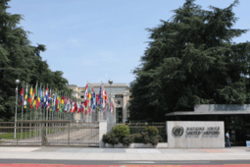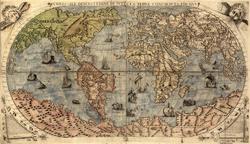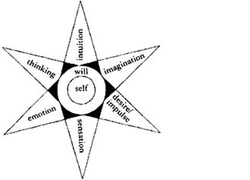AUDIO RECORDING
Marco Toscano-Rivalta
Chief, Office of the Special Representative of the Secretary-General for Disaster Risk Reduction (UNISDR) at the United Nations
"...a centre for harmonizing the actions of nations..."
Some of you may wonder about this title, its meaning and reason, and mostly about the connection with the theme of today.
It is a quote from art.1 of the United Nations Charter, the one that specifies the four purposes of the UN. These are:
1) “To maintain international peace and security
2) To develop friendly relations among nations
3) To achieve international co-operation
4) To be a centre for harmonizing the actions of nations in the attainment of these common ends.”
Let us focus on the final purpose, which suggests that, unless and until the United Nations becomes such a Centre capable of harmonising actions we may be missing an important piece in the puzzle, and thus it remains difficult to attain the three other purposes.
So let’s ask:
What does it mean to be a Centre?
What skills and qualities does a Centre need to have to harmonise actions?
How are those skills and qualities acquired?
What is it a Centre of? What, who is at the periphery?
How does this Centre come into existence? Who does the necessary work?
These questions help to define the field of service of such a Centre.
The field of service of this Centre is defined by the first three purposes already cited; or more simply, that this field of service is humanity, namely the further development of humanity and its potential. The focus on humanity and its needs for peace, security, friendly relations and respect for human rights, also brings about an increasing interest in the other kingdoms (animal, vegetable and mineral) – so far mainly considered as resources, yet in this manner opening the way to the question whether in turn humanity is, and sees itself as, a resource for the other kingdoms, and in that case, what resource?
From this perspective, we can also note that the very process of “globalisation” is in itself a dimension, now emerging with clarity, of this process concerning human development. Globalisation is about human relations, it is about humanity discovering itself as one.
What we probably need to do is to try to understand what globalisation really means; for example, can we venture to say that globalisation is not “just happening”, and rather that it has a specific meaning, if not even a function? Can we say that globalisation is about rendering those links across humanity more evident, and at the same time evidencing new potentials? Can we say that it is related to the emergence of a global consciousness? And that this emerging global consciousness is bringing into focus the existence of a centre?
In this journey toward the establishment of “…a Centre for harmonising the actions of nations…” an interesting question emerges: “Does a plan exist?” The Ageless Wisdom gives us some important pointers: “The entire rhythm of international thinking has to be altered” in order to move from “chaos” to “ordered beauty”. In other words, in order to address the challenges of today and transform them, we need to modify our collective/international thinking.
So it could be said that the plan directs our attention to two things: “rhythm” and “international thinking”. But this raises the further question: what is “international thinking”? To address this question, we need to consider a related one: why has the United Nations come into existence in 1945, in this specific moment in humanity’s evolution, and not in 54 BC, 1268, or 2674?
I will attempt to look for an answer through a story, and analogy between the development of a human being, and a look at the history of the past 600 years, which, taken together, tells us something of significance.
The individual human being develops a physical/etheric body, then an emotional body, a mental body and, through this, an integration of them all into a personality which can be infused with higher energies; and suggested that the same thing seems to be happening to humanity collectively, on a planetary scale.
Thus, it is only through the navigators of the 14th and 15th centuries that for the first time in recorded history all the lands started being discovered and mapped, so revealing the oneness of the planet and of the human family through its various facets. This could be seen as representing the emergence into human consciousness of the physical oneness of humanity.
Through the development of science, and in particular of physics, in the 19th and early 20th century, humanity has come to know the world as one from an energy point of view, including Einstein’s famous equation correlating energy and mass. This could be imagined as the emergence in human consciousness of the understanding of the existence of the etheric body of humanity.
World Wars 1 and 2 could be read as evidence of the existence of the emotional body of humanity. This seems to be also indicated by the emergence and effectiveness of the work of the Red Cross. It can be observed on a daily basis through the global transmission of concern following, for instance, a disaster.
If we keep going along this line, we should now look for an indicator of the emergence into human consciousness of a collective mental body. It is my impression that such “evidence” is the creation of the United Nations.
As far as I am aware, it is the first time in the history of humanity that an alliance has emerged with the purpose of collectively thinking and implementing plans for the good and the future of humanity – and increasingly of the Planet. This international cooperation for development can be seen as an extremely important attempt to imagine what a better future for humanity can be, and devising the plans and actions to get there. Against this background, we can see that the purpose of the United Nations is indeed to alter “international thinking” and give it a “rhythm”. The “centre for harmonising the actions of nations” needs to operate through positively influencing “international thinking”. Rhythm is key, as it creates resonance in all who are ready to serve humanity.
The periodic United Nations World Conferences can then be seen as an indicator of a stimulated alteration and attempted synchronisation of international thinking which then leads to action, like the agreement on, and implementation of, the Millennium Development Goals which, for instance, have brought about an effective reduction of poverty on a planetary scale.
For every good plan to succeed, it needs a model to be inspired and guided by. What model do we have at our disposal? Do we have other centres that play a similar function that can be looked at?
We are lucky – the answer is yes, and an indication is provided by many of those scientists, psychologists, and philosophers who have shed light on the will and its relation with our personality. I would like in particular to refer to Roberto Assagioli, and in particular to his works on “The Act of Will” and his “psychosynthesis”.
Assagioli presents the will as that key human “function” which enables the personality, the ego, to harmonise other functions, allowing a human being to develop his highest potential and play his part in life.
He outlines some of the inherent dimensions of the “will” which we need to consciously develop: aspects, qualities, and stages. The first category, aspects, is the most basic, and represents the facets that can be recognized in the fully developed will. The second category, qualities, refers to the expression of the will. Finally, the stages of the will refer specifically to the process of willing, the act of will as it unfolds from beginning to end.
The aspects of the fully developed human will are:
1. Strong will,
2. Skilful will,
3. Good will, and
4. Transpersonal Will
The qualities of the fully developed human will are:
1. Energy—Dynamic Power—Intensity
2. Mastery—Control—Discipline
3. Concentration—One-Pointedness—Attention— Focus
4. Determination—Decisiveness—Resoluteness—Promptness
5. Persistence—Endurance—Patience
6. Initiative—Courage—Daring
7. Organization—Integration—Synthesis
They can be developed and evoked as necessary in the right proportions and in the proper mode as the situation demands. The fully developed will knows how to use these differing qualities.
The stages of the fully developed human will are:
1. The Purpose, Aim, with a Goal, based on Evaluation, Motivation, and Intention.
2. Deliberation.
3. Choice and Decision.
4. Affirmation: the Command, or "Fiat," of the Will.
5. Planning and Working Out a Program.
6. Direction of the Execution.
A fundamental point is that the will does not substitute itself for the other functions of the personality, rather it aims at a constructive partnership, at empowering and developing them.
The will is also that “tool” which enables the ego to bring to a synthesis all those different and varied parts which “live” within us, and that if and when not aligned, seem to pull us in all possible directions, creating a sort of internal chaos of confusion, fears, doubts, frustrations, etc.. From this perspective it is not too difficult to see the correlation between the external world with all its different parts – nations, corporations, civil society organisations, races, etc – and our inner world.
And here comes another question: how well do we use our will? In essence, the will represents the key toward the emergence of the “centre for harmonizing the actions of nations in the attainment of these common ends”.
From this perspective we can also see the link between the will and the theme of Energy Follows Thought. Indeed the will is instrumental in the processes of “impression”, “creative thinking” and “direction” which lie behind the truism “energy follow thought”. Therefore, understanding the will, its nature, its functioning, its characteristics, and the fact that we need to dedicate time and effort to its development, is of fundamental importance.
The work to build a centre for harmonising the actions of ourselves, or of nations, needs to follow a specific program. In order to harmonise actions, actions need to be initiated. Many forms of action need to be explored in order to channel the will existing in, and to be manifested by, 7.2 billion people.
The work of the United Nations is intended to empower and enlarge people's choices. This has materialised in a number of ways, including: supporting the end of colonialism, and, as a result, the establishment of many new states; the development and codification of international law; development programs aimed at the empowerment of people; supporting elections and the monitoring and protection of human rights; and many more.
Forms of action are unlimited, and new ones can always be created. It is worth noting that the experimentation with “Form” through the creation of forms seems to be a key characteristic of our Planet vis-à-vis others within the Solar system.
We are all familiar with the truism “unity in diversity”. Its polar opposite “diversity in unity” is of no less importance, and it is indeed the process followed by Mother Nature. “Diversity in unity” is somehow even more powerful a concept: building on a certain degree of confidence in, and recognition of, the fundamentals of Nature, which include humanity, it invites us to experiment, to create new forms in harmony with it – forms which need to contribute to the aims of establishing right relations among humans, and between humans and other kingdoms. Music science itself tells us that harmony is all about right relations between different sounds.
From this perspective, we can appreciate that an increasing multitude of brains, minds and hearts, if aligned through a new rhythm in international thinking, can ignite an incredible potential, which is, as of today, still largely untapped. The work carried out through such a necessary variety of initiatives for the good of humanity and beyond, needs to be nurtured and reinforced by holding the vision of what we are doing. One way of presenting the meaning of what humanity is doing, is that we, individually and collectively, are training ourselves and learning how to think and “will”.
The key and challenging point to accept is that we are still on the learning curve… The good thing is that we are doing it!
We need to believe and trust humanity’s power if we want it to flourish, as Humanity's consciousness is much more awake that we believe it is. I think there is some evidence that humanity as an existing centre is already operating beyond and above our individual conscious level, applying laws and principles more consistently than we, as individuals, are doing…
I think that there is an interesting parallel between article 1.4 of the UN Charter, the 4th Stanza of the Great Invocation, and the 4th Ray:
“To be a centre for harmonizing the actions of nations in the attainment of these common ends.”
“From the centre which we call the race of men
Let the Plan of Love and Light work out
And may it seal the door where evil dwells.”
“Harmony through conflict”
There seem to be some tension between the diversification of forms on one side, and the need to find a shared point, a common ground and vision, on the other side. This tension between these two apparent polar opposites and tendencies can find a point of synthesis through order and organisation – and it is probably not by coincidence that the question of “governance” is so prominent in national and international discourses. There is a pressing call for both world and local governance.
The question is, how to ensure that all the entities of a collective participate in the collective act of Will, from intention to realisation, thus mobilising and managing the power of the collective through the collective? What choices do we need to take to organise and structure that centre for harmonising actions? How can we get ready to use the energy that the Fourth Ray of harmony through conflict will start making available as from 2025? What opportunities will this open?
It is important to carefully ponder on these and similar questions. The work is just at the beginning, and exciting.
I would like to conclude by quoting what Dag Hammarskjold said, when taking office as the second Secretary-General of the United Nations:
The weight we carry is … based solely on… our maturity of judgment.
This was on his side a clear understanding of the responsibilities we bear as indeed “energy follows thought”!



